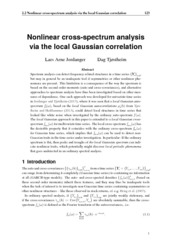Nonlinear cross-spectrum analysis via the local Gaussian correlation
Abstract
Spectrum analysis can detect frequency related structures in a time series \(\{Y_t\}_{t\in\mathbb{Z}}\), but may in general be an inadequate tool if asymmetries or other nonlinear phenomena are present. This limitation is a consequence of the way the spectrum is based on the second order moments (auto and cross-covariances), and alternative approaches to spectrum analysis have thus been investigated based on other measures of dependence. One such approach was developed for univariate time series in Jordanger and Tjøstheim (2017), where it was seen that a local Gaussian auto-spectrum \(f_{v}(\omega)\), based on the local Gaussian autocorrelations \(\rho_v(\omega)\) from Tjøstheim and Hufthammer (2013), could detect local structures in time series that looked like white noise when investigated by the ordinary auto-spectrum \(f(\omega)\), The local Gaussian approach in this paper is extended to a local Gaussian cross-spectrum \(f_{kl:v}(\omega)\) for multivariate time series. The local cross-spectrum \(f_{kl:v}(\omega)\) has the desirable property that it coincides with the ordinary cross-spectrum \(f_{kl}(\omega)\) for Gaussian time series, which implies that \(f_{kl:v}(\omega)\) can be used to detect non-Gaussian traits in the time series under investigation. In particular: If the ordinary spectrum is flat, then peaks and troughs of the local Gaussian spectrum can indicate nonlinear traits, which potentially might discover local periodic phenomena that goes undetected in an ordinary spectral analysis.
